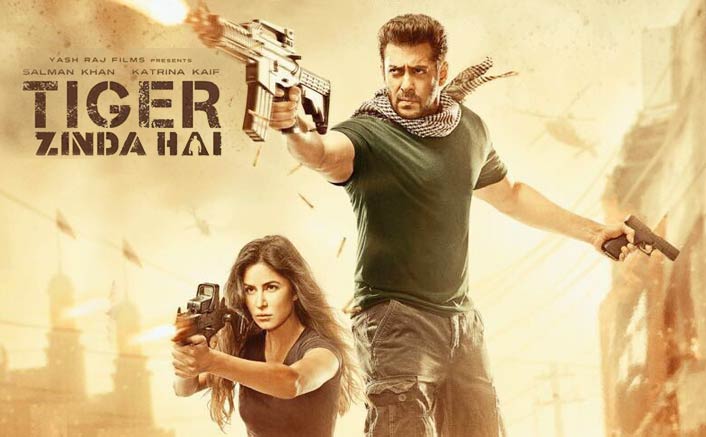Tiger Zinda Hai (which translates to “Tiger is Alive” in English) is a Hindi film directed by Ali Abbas Zafar, and stars Salman Khan and Katrina Kaif. It is the second film in the Tiger series. The film is subtitled in English for its American exhibition.
A terrorist group in the Middle East captures Indian and Pakistani nurses and holds them hostage. Ambassadors want to rescue their respective country’s nurses before an American airstrike will take place on the compound against the terrorists in a week. Indian authorities call for special agent Tiger, who has gone into hiding following his previous battles, who has since married a Pakistani agent and had a son. Tiger returns to the fray, with an elaborate plan and a team of specialized agents, ready and willing to do what is necessary to free the nurses.
Okay, I’ll go ahead and admit it – I had never heard of this film, and certainly did not know that it was a sequel to an earlier successful Indian film. I saw the movie on a whim, knowing little going in, but am glad I gave it a chance. Salman Khan steals the show as Tiger, and the film features spectacular, over-the-top action sequences as well as riveting setpieces and production; this is one of the most expensive Indian films ever made, but also one of the highest grossing. While superb, however, the film is held back by an overlong run time, an abundance of unnecessary scenes that try to outdo the last, and its negative, one-dimensional depiction of Americans.
The biggest positive about the film is Salman Khan as Tiger, the Special Forces agent sent to rescue the nurses prior to the airstrike. I have not seen the first film starring the character (a wrong I hope to right soon), but this guy steals every single scene he is in. The character’s intro scene, featuring him battling wolves on a downhill slope while protecting his young son, is an instant attention getter, and the only thing wrong with this scene is that it was not put at the beginning of the movie; as is, we don’t see Tiger for the first time until nearly half an hour in. This would have made for a great James Bond-esque pre-credits sequence, and its impact is somewhat diminished by its late arrival. From family interaction scenes to straight-up action later in the film, this guy owns the film. He’s more or less the Indian John Rambo, and I would not be surprised to see a third film starring the character eventually be released.
When this film brings on the action scenes, they do not let up. These sequences are brilliantly filmed and choreographed, with hand-to-hand fights, explosions, chases, weapons, and everything in between. Your eyes are glued to the screen during the film’s many action sequences. It was one of the most expensive Indian films ever made, and I am happy to announce that said budget did not go to waste.
However, the film does have a few things that hold it back from greatness. This is Tiger’s film, first and foremost. The problem with this is that everyone else is underdeveloped by comparison and feels one-dimensional. Even Tiger’s own wife, who ends up entering the plot in a larger scale later on, is overshadowed by her husband. Many of the characters had potential, but everyone lives in Tiger’s shadow. Even the central villains end up feeling like flat, generic terrorists.
Another issue is the run time. At just under three hours, this is far too long a film for an action thriller. I give the movie credit for never getting “boring,” but each action scene tries to overtake the last, and it is not long before the film sacrifices depth and a borderline espionage plot of sorts for big, noisy action sequences that do not let up; these “side trips” serve to drag out and prolong the movie. Many sequences could have been excised from the film; a scene of Tiger and his wife celebrating their wedding anniversary, which feels like something out of a romantic comedy, comes to mind. The film should not have been much longer than two hours.
The other problem with the film is its overly negative depiction of Americans. The Americans clearly are played by foreigners, trying poorly to imitate American accents. The film also depicts the Americans as heartless savages who show no reservations about bombing a building to kill a terror leader even if it involves killing hostages, and murdering Middle Eastern business people that will not give up their oil at a fair price. These depictions are laughably bad and offensive, and it is fortunate that they are not at the forefront throughout the movie.
Okay, Tiger Zinda Hai has a lot of issues. It’s way too long, everyone pales in comparison to the title character, and the Americans are depicted in an unflattering and outright offensive light. And yet, when the movie works, it works exceptionally well, with well-produced, over-the-top action scenes and many fantastic sequences throughout. If the movie is playing at a theater near you, and you are looking for action and thrills, Tiger Zinda Hai should fit the bill nicely.
Rating: Three out of four stars.
Tiger Zinda Hai is not rated by the MPAA, though my recommended rating is PG-13, for stylized action violence (albeit largely bloodless) throughout, and some intense moments.
DISCLAIMER: All images in this review are the copyright of their respective owners. For promotional use only. All rights reserved.

